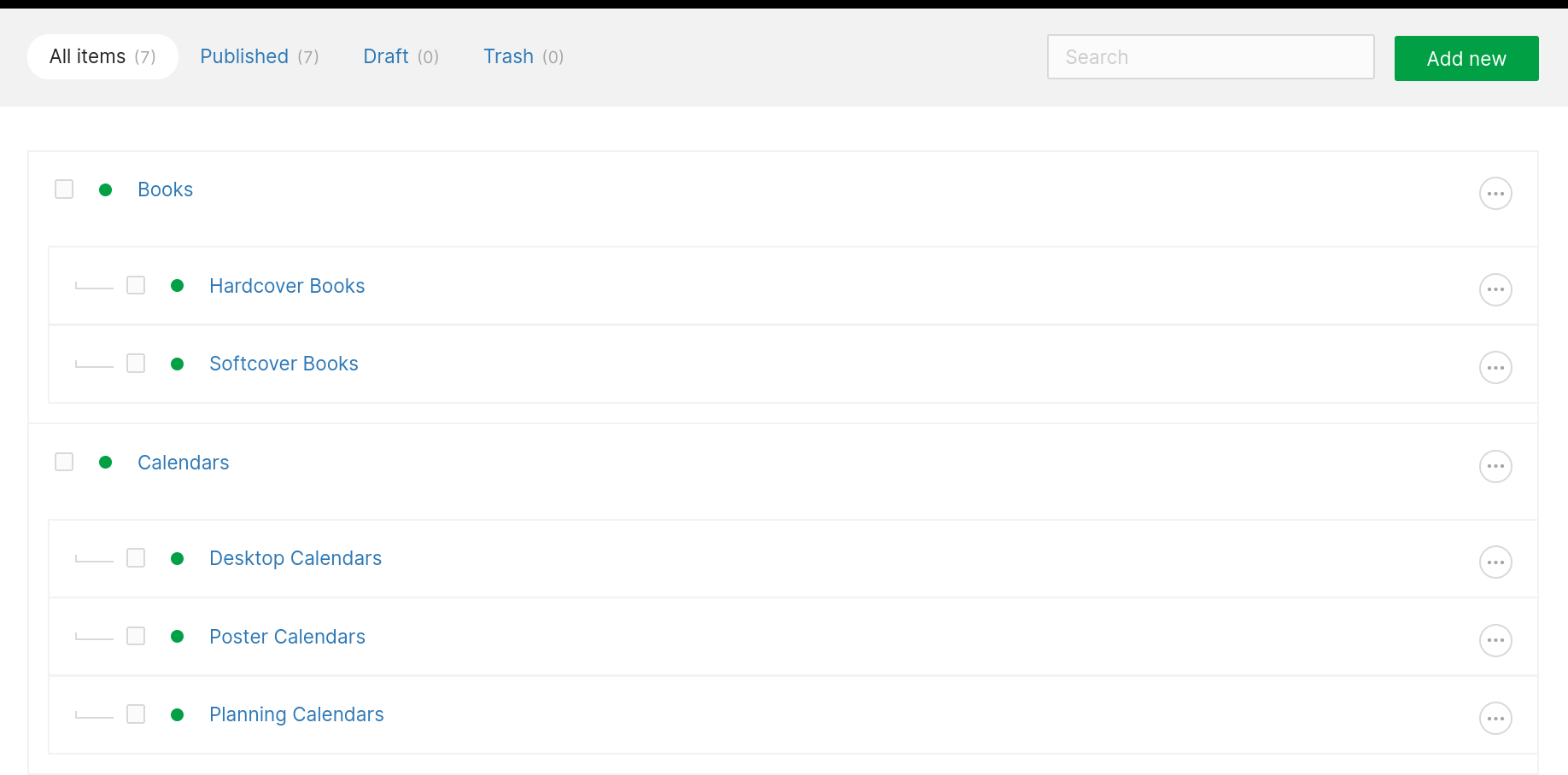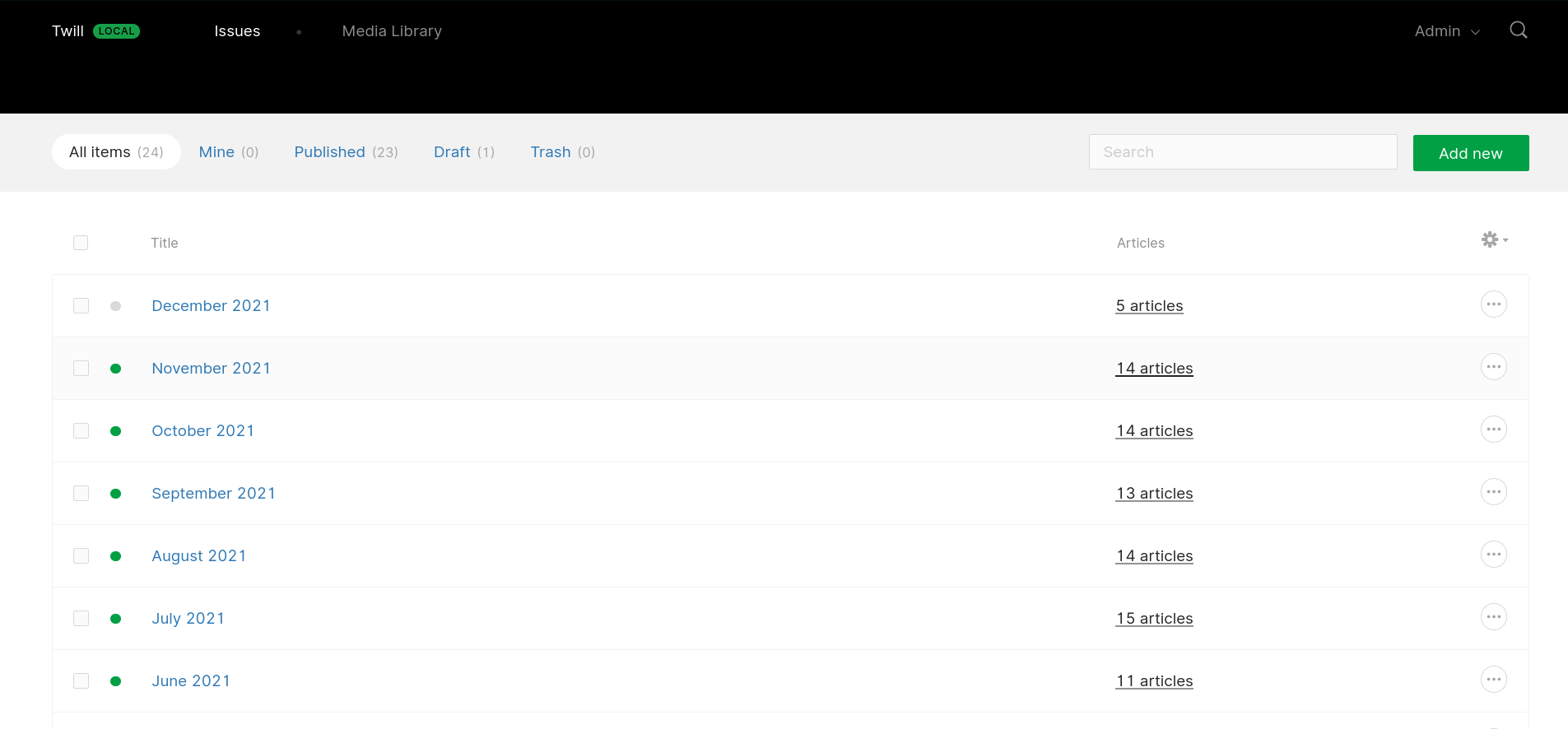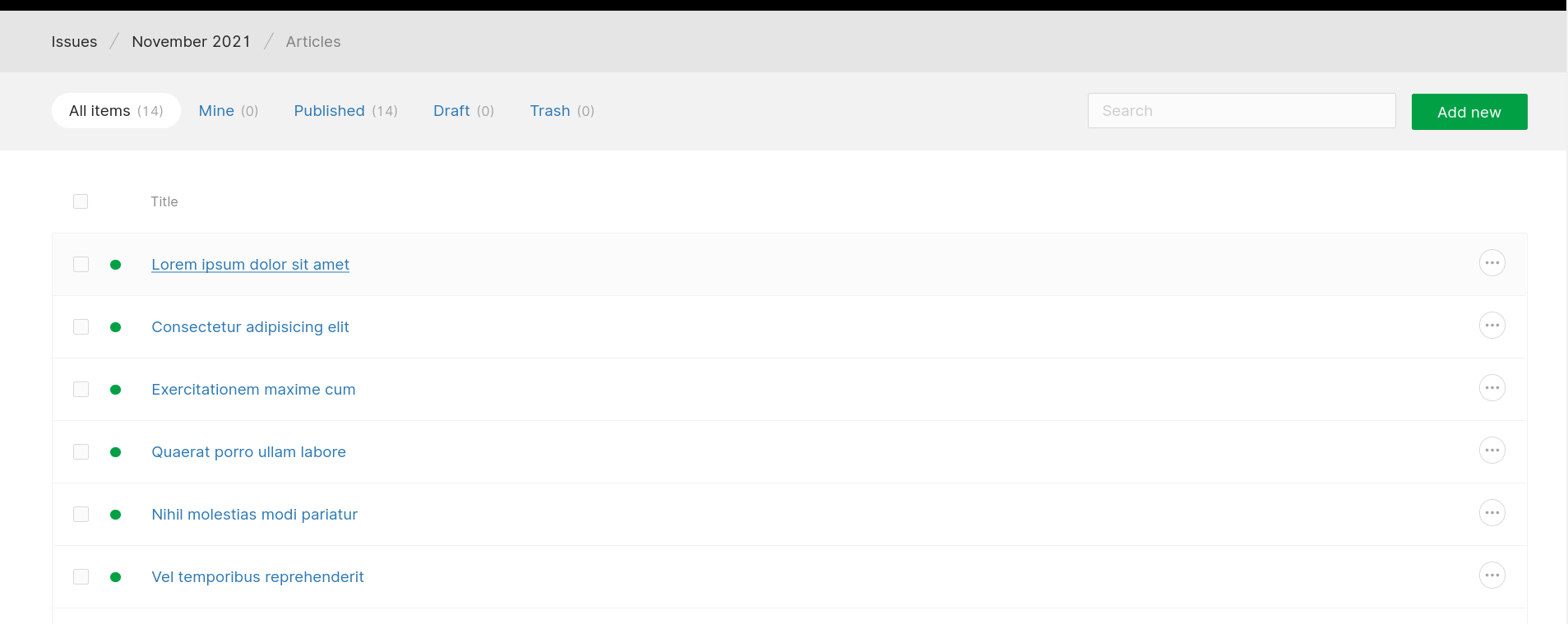# Nested Modules
Out of the box, Twill supports 2 kinds of nested modules: self-nested and parent-child.
# Self-nested modules
Self-nested modules allow items to be nested within other items of the same module (e.g. Pages can contain other Pages):

# Creating self-nested modules
You can enable nesting when creating a new module with the --hasNesting or -N option:
php artisan twill:make:module -N pages
This will prefill some options and methods in your module's controller and use the supporting traits on your model and repository.
This feature requires the laravel-nestedset package, which can be installed via composer:
composer require kalnoy/nestedset
# Working with self-nested items
A few accessors and methods are available to work with nested item slugs:
// Get the combined slug for all ancestors of an item in the current locale:
$slug = $item->ancestorsSlug;
// for a specific locale:
$slug = $item->getAncestorsSlug($lang);
// Get the combined slug for an item including all ancestors:
$slug = $item->nestedSlug;
// for a specific locale:
$slug = $item->getNestedSlug($lang);
To include all ancestor slugs in the permalink of an item in the CMS, you can dynamically set the $permalinkBase property from the form() method of your module controller:
class PageController extends ModuleController
{
//...
protected function form($id, $item = null)
{
$item = $this->repository->getById($id, $this->formWith, $this->formWithCount);
$this->permalinkBase = $item->ancestorsSlug;
return parent::form($id, $item);
}
}
To implement routing for nested items, you can combine the forNestedSlug() method from HandleNesting with a wildcard route parameter:
// file: routes/web.php
Route::get('{slug}', function ($slug) {
$page = app(PageRepository::class)->forNestedSlug($slug);
abort_unless($page, 404);
return view('site.page', ['page' => $page]);
})->where('slug', '.*');
For more information on how to work with nested items in your application, you can refer to the laravel-nestedset package documentation (opens new window).
# Parent-child modules
Parent-child modules are 2 distinct modules, where items of the child module are attached to items of the parent module (e.g. Issues can contain Articles):

Items of the child module can't be created independently.
# Creating parent-child modules
We'll use the slug and position features in this example but you can customize as needed:
php artisan twill:make:module issues -SP
php artisan twill:make:module issueArticles -SP
Add the issue_id foreign key to the child module's migration:
class CreateIssueArticlesTables extends Migration
{
public function up()
{
Schema::create('issue_articles', function (Blueprint $table) {
// ...
$table->unsignedBigInteger('issue_id')->nullable();
$table->foreign('issue_id')->references('id')->on('issues');
});
// ...
}
}
Run the migrations:
php artisan migrate
Update the child model. Add the issue_id fillable and the relationship to the parent model:
class IssueArticle extends Model implements Sortable
{
// ...
protected $fillable = [
// ...
'issue_id',
];
public function issue()
{
return $this->belongsTo(Issue::class);
}
}
Update the parent model. Add the relationship to the child model:
class Issue extends Model implements Sortable
{
// ...
public function articles()
{
return $this->hasMany(IssueArticle::class);
}
}
Update the child controller. Set the $moduleName and $modelName properties, then override the getParentModuleForeignKey() method:
class IssueArticleController extends BaseModuleController
{
protected $moduleName = 'issues.articles';
protected $modelName = 'IssueArticle';
protected function getParentModuleForeignKey()
{
return 'issue_id';
}
}
Update the parent controller. Set the $indexColumns property to include a new Articles column. This will be a link to the child module items, for each parent.
class IssueController extends BaseModuleController
{
protected $moduleName = 'issues';
protected $indexColumns = [
'title' => [
'title' => 'Title',
'field' => 'title',
],
'articles' => [
'title' => 'Articles',
'nested' => 'articles',
],
];
}
Add both modules to routes/admin.php:
Route::module('issues');
Route::module('issues.articles');
Add the parent module to config/twill-navigation.php:
return [
'issues' => [
'title' => 'Issues',
'module' => true,
],
];
Then, rename and move the articles/ views folder inside of the parent issues/ folder:
resources/views/admin/
└── issues
├── articles
│ └── form.blade.php
└── form.blade.php
...
# Using breadcrumbs for easier navigation
In the child module controller, override the indexData() method to add the breadcrumbs to the index view:
class IssueArticleController extends BaseModuleController
{
// ...
protected function indexData($request)
{
$issue = app(IssueRepository::class)->getById(request('issue'));
return [
'breadcrumb' => [
[
'label' => 'Issues',
'url' => moduleRoute('issues', '', 'index'),
],
[
'label' => $issue->title,
'url' => moduleRoute('issues', '', 'edit', $issue->id),
],
[
'label' => 'Articles',
],
],
];
}
}

Then, override the formData() method to do the same in the form view:
protected function formData($request)
{
$issue = app(IssueRepository::class)->getById(request('issue'));
return [
'breadcrumb' => [
[
'label' => 'Issues',
'url' => moduleRoute('issues', '', 'index'),
],
[
'label' => $issue->title,
'url' => moduleRoute('issues', '', 'edit', $issue->id),
],
[
'label' => 'Articles',
'url' => moduleRoute('issues.articles', '', 'index'),
],
[
'label' => 'Edit',
],
],
];
}
